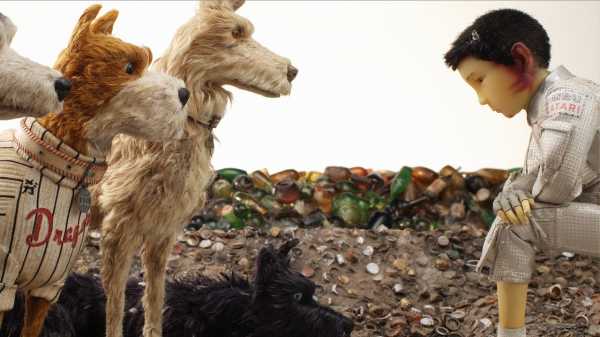
Wes Anderson’s new film “Isle of Dogs,” a comedic drama realized with
stop-motion animation (like his film “Fantastic Mr. Fox,” from 2009) is both a
persuasive argument for big-screen viewing and for watching at home via
streaming or a disk (preferably Blu-ray). The movie is overwhelming, in
the very best sense: the pointillistic profusion of the movie’s visual
details—décor, action, and the gestures of the characters (all of which
are puppets, deftly manipulated, frame by frame)—and, for that matter,
its drolly nuanced sound mix, make a big-screen viewing a prime
necessity. But that very profusion of visual details, plus the speed
with which the movie’s intricate story is told, the flashes forward and
back, and the quick introduction of a wide array of characters and
subplots, make a first viewing merely a rough draft of an experience and
invite savoring, in private, in slow motion and in freeze-frame.
“Isle of Dogs” is the third film in a virtual trilogy, following
“Moonrise
Kingdom”
and “The Grand Budapest
Hotel”—a
trilogy of revolt. “Moonrise Kingdom” shows two teen-agers overturning
narrow mores and narrow legalism while displaying their own inspired
fusion of new and old styles (helped by a deus ex machina who is none
other than God himself). In “The Grand Budapest Hotel,” a true sense of
style, restraint, and pleasure functions in two ways: as both a mark of
and a weapon against the depravities of a tyrannical and racist regime.
With “Isle of Dogs,” Anderson looks even more closely at the victims of
a radically exterminationist ruler, and, in effect, inverts the terms of
“The Grand Budapest Hotel.” Thrust into situations of utter degradation,
places of utter ruin, and fates of utter despair, these victims unite in
resisting the forces that would destroy them and, in the process, tap
into a latent sensibility and forge a sublime style of their own.
The victims in “Isle of Dogs,” of course, happen to be canines. In the
fictitious Japanese city of Megasaki, twenty years in the future, they
are deported en masse to a fictitious offshore garbage dump, known as
Trash Island, under orders from the city’s tyrannical Mayor Kobayashi
(voiced by Kunichi Nomura, who co-wrote the story with Anderson, Jason
Schwartzman, and Roman Coppola). (There’s a mythic backstory of the
Kobayashi clan’s ancient hatred for dogs.) The pretext for that
deportation is public health: the city’s canine population is widely
infected with dog flu, which can be transmitted to humans, as well as
with snout fever. But at the rigorously orchestrated rally at which the
mayor declares his intentions, he allows, pro forma, a speaker in
opposition—the scientist Watanabe, from the Science Party, who’s there
with his colleague, named (and voiced by) Yoko Ono. Watanabe (voiced by
Akira Ito) announces that he has nearly completed a cure for dog flu and
a treatment for snout fever, but the pro-Kobayashi public filling the
hall shout him down and pelt him with produce and garbage. From its
basic setup, “Isle of Dogs” is a fantasy that reflects no aspect of
Japanese current events but, rather, the xenophobic, racist, and
demagogic strains of contemporary American politics.
The dogs on Trash Island are being left to die from malign neglect.
They’re all afflicted with dog flu, and they have nothing to eat but the
garbage scraps that they scavenge, and there’s little clean water to
drink. The action is centered on five of them: Rex (voiced by Edward
Norton), Duke (Jeff Goldblum), King (Bob Balaban), Boss (Bill Murray),
and Chief (Bryan Cranston). What distinguishes Chief is that, unlike the
other four, all former house pets, he is a stray—and, as a stray, who
has led a tough life, he has no patience for his cohorts’ nostalgia for
creature comforts. He girds them for a fight to survive.
Their sense of battle, however, is galvanized by the arrival of a human:
the twelve-year-old Atari Kobayashi (voiced by Koyu Rankin), the mayor’s
ward and distant relative, whose parents were killed in a train accident
years earlier. When Atari was brought into the mayor’s home, he was
given a guard dog named Spots (Liev Schreiber). To launch the anti-dog
campaign, Mayor Kobayashi makes Spots the first deportee to Trash
Island; but Atari secretly commandeers a small plane in the hope of
rescuing Spots. The plane crash-lands, and the band of five dogs vote
not to eat Atari but to rescue him—and to help him find Spots, in a
mission that they know to be all but hopeless but that reaffirms their
dignity and engages their righteous outrage at their persecutors.
The Japanese characters speak Japanese; their dialogue isn’t subtitled,
but, rather, is frequently translated by onscreen simultaneous
translators (one is voiced by Frances McDormand); the one American
character speaks English; the dogs speak English. The decision not to
subtitle the Japanese speakers has been criticized, as by Justin Chang
in the Los Angeles
Times,
for diminishing the prominence of the movie’s Japanese characters; yet
the bulk of the dialogue is translated, and the most conspicuous
non-translations, when Atari speaks to the dogs, replicates the mutual
incomprehension of the species—there’s even a winking yet, in context,
touching aside by one of the dogs, who, upon rescuing Atari, says, “I
wish someone spoke his language.” The center of the movie is neither the
Japanese characters nor the American one; it’s the canine ones. The
movie looks closely at deportation, internment in a prison camp, and the
threat of extermination—all from the perspective of the victims.
No contemporary director delights like Anderson does in depicting
military or quasi-military organization, its somewhat ludicrous yet
deeply earnest and potentially very effective rituals and hierarchies.
In that regard, “Isle of Dogs” is something like Anderson’s first John
Ford movie—filled with the emotionalism of respect and principle,
embodied in the dogs’ own organization and in their relationships with
humans. A flashback to the first encounter of Atari and Spots is an
extraordinarily tender scene that’s undergirded by a self-aware,
steadfast canine devotion—the very root of the action that follows.
Chief is a wild dog who’s aware of his own recklessness, which presents
a danger to others (and to himself—he lost his one chance at becoming a
house pet when he bit a child). When he is thrust into Atari’s company,
he confronts his lifelong conflict between impulses toward obedience and
disobedience. When Anderson films the ruins of Trash Island, he
aestheticizes and stylizes them without beautifying them, and he does
the same thing with the disciplined and symmetrical order of Mayor
Kobayashi’s public rallies (a Riefenstahlian twist on a contemporary
American malady). Andersonian beauty is principled, passionate,
liberating, and the contrast between mere order and beauty is presented
nowhere more clearly in his oeuvre than in “Isle of Dogs.” (For that
matter, it’s a mistake to consider Anderson’s work in animation a
pursuit of total control: the director’s work with his animators
involves vast amounts of back-and-forth, of attempts and suggestions,
variations and surprises; their personal and physical involvement, even
if offscreen, is no less vital to the film than the presence of actors
in a live-action movie.)
There’s another character who’s crucial to the resistance to Mayor
Kobayashi’s reign of terror: an American foreign-exchange student named
Tracy Walker (Greta Gerwig), who is the only white student in her class
in Megasaki Senior High. I was at first surprised that Anderson would
cast a white foreigner as the central figure in the political liberation
of Megasaki City, but Tracy’s presence—virtually inviting the xenophobic
wrath of the demagogic ruler—meshes with the parallels that Anderson
develops with current American politics. The connection becomes even
clearer when—not to give away too much—Mayor Kobayashi is revealed to be
a kleptocrat whose policies are driven by his business interests. What’s
more, the climactic line that unleashes the movie’s dénouement is
Tracy’s interruption of Mayor Kobayashi’s campaign rally with the cry,
“He’s stealing the reëlection!” (The suggestion that citizens of the
future Megasaki City seem passive in the face of tyranny could, to an
outside observer, hold quite as well here, now.)
For Anderson, Japan is a sort of mirror-America, a country that has as
prominent, as rich, and as inspiring a cinematic image, due to its movie
industry and to the artists whom it sustained; the Japan of “Isle of
Dogs” is a movie-made place. “Isle of Dogs” doesn’t draw upon Japanese
history, doesn’t delve into Japanese politics, doesn’t consider the
present-day specifics of Japanese society. The movie’s future-Japan (a
future that is decoratively imbued, Anderson-style, with industrial
styles and technological devices of the fifties and sixties) is akin to
the fictitious Central European country of Zubrowka in “Grand Budapest,”
which is as much a movie creation—a reference to films by Ernst Lubitsch
and other nineteen-thirties filmmakers—as is the futuristic-dystopian
Japan of “Isle of Dogs.” Even the geography of Japan is fictitious (it
includes the so-called Middle Finger Islands which the dogs must cross
in order to reach the distant Cuticles). The film’s political references
have nothing to do with real-life Japan, either; they’re heralded very
early on, in the voice-over narration (by Courtney B. Vance) that refers
to “the Japanese archipelago,” a word that instantly resounds not with
Japanese history but with exposés of Soviet prison camps.
The movie’s Japan resembles Zubrowka in another way: like Lubitsch’s
comedies of manners, the movies of Kurosawa, Mizoguchi, Ozu, and others
show a society in which the expression of emotion is modulated through
conventional hints, deflections, and indirections. The iconography of
Japan, as represented copiously in Japanese movies, art, and
architecture reflects a culture of shared formalities. The demagogy of
Mayor Kobayashi (like the ultimate villainy of his henchman, the
Major-Domo Hatchet-Man, voiced by Akira Takayama) stands out all the
more for saying and doing, with disruptive ferocity, what few in his
position would be likely to express publicly. (Here, too, Japan is a
stand-in for current-day America.) But the virtues of mutually respected
formalities emerge in a sort of epilogue, when Mayor Kobayashi publicly
admits (in a gesture virtually unimaginable in American public life), “I
have no honor,” and makes a vast offering in repentance. (No spoilers;
it’s not seppuku but a brilliantly conceived, humanistic, life-giving
substitute.)
As ever in Anderson’s work, there’s a powerful strain of romanticism in
“Isle of Dogs,” both in the portrayal of the uprising (the lonely
three-tone whistle that serves as the dogs’ sign of recognition, the
abandoned Spots’s Chaplinesque stare into camera) and in matters of
actual romance (two involving dogs and one involving a teen or tween
crush). I confess that I was surprised by the gender separation of dogs
on Trash Island—the only prominent female dogs, Nutmeg (Scarlett
Johansson) and Peppermint (Kara Hayward), aren’t fighters. Nutmeg is a
former show dog (though she tells Chief, “That’s what I do, it’s not my
identity”), deft and dainty. Peppermint, a survivor of a distant, woeful
camp of experimentation on animals, is also slender and domestic. The
martial masculinity of the movie’s band of fighting dogs is an aesthetic
holdover—a reference to a cinematic and literary heritage that is
receiving long-overdue critiques in Hollywood today, but Anderson seems
to replicate it unquestioningly. Given the central place of misogyny in
the current American strain of political madness, and the clarity and
force of the movie’s allegory of rage at that madness, that absence is
all the more gaping.
Sourse: newyorker.com






